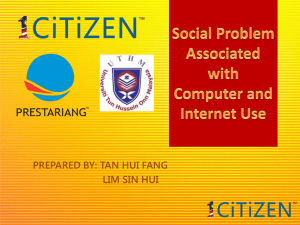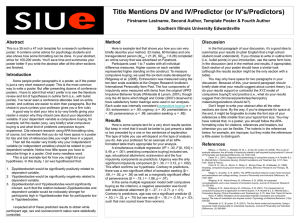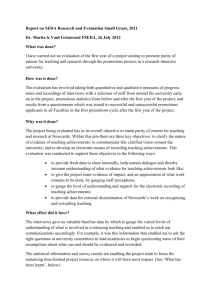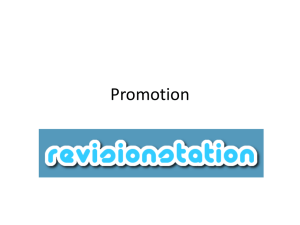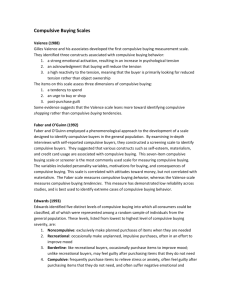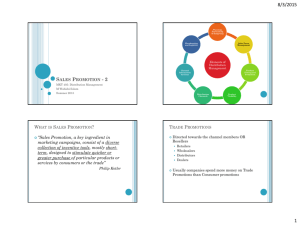towards a framework for understanding compulsive buyers
advertisement
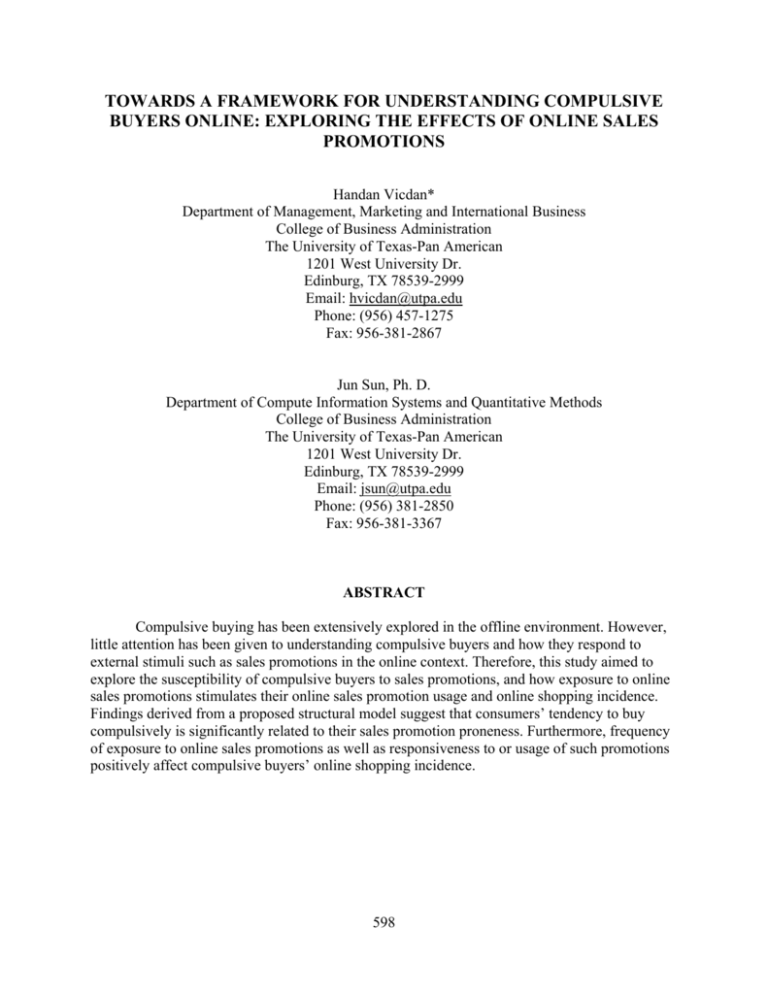
TOWARDS A FRAMEWORK FOR UNDERSTANDING COMPULSIVE BUYERS ONLINE: EXPLORING THE EFFECTS OF ONLINE SALES PROMOTIONS Handan Vicdan* Department of Management, Marketing and International Business College of Business Administration The University of Texas-Pan American 1201 West University Dr. Edinburg, TX 78539-2999 Email: hvicdan@utpa.edu Phone: (956) 457-1275 Fax: 956-381-2867 Jun Sun, Ph. D. Department of Compute Information Systems and Quantitative Methods College of Business Administration The University of Texas-Pan American 1201 West University Dr. Edinburg, TX 78539-2999 Email: jsun@utpa.edu Phone: (956) 381-2850 Fax: 956-381-3367 ABSTRACT Compulsive buying has been extensively explored in the offline environment. However, little attention has been given to understanding compulsive buyers and how they respond to external stimuli such as sales promotions in the online context. Therefore, this study aimed to explore the susceptibility of compulsive buyers to sales promotions, and how exposure to online sales promotions stimulates their online sales promotion usage and online shopping incidence. Findings derived from a proposed structural model suggest that consumers’ tendency to buy compulsively is significantly related to their sales promotion proneness. Furthermore, frequency of exposure to online sales promotions as well as responsiveness to or usage of such promotions positively affect compulsive buyers’ online shopping incidence. 598 INTRODUCTION The worldwide consumer culture is being exposed to several technological and communicational improvements as well as to ubiquitous marketing efforts by multinational firms. In such an environment, it is not surprising to see the blossoming trend of abnormal consumer behavior, such as compulsive buying, triggered by transmission of marketing messages via the Internet and increased levels of commercialization. The Internet, while making shopping so easy for consumers, will certainly tap into the dark side of consumer behavior, that is compulsive buying (Lyons and Henderson, 2000). Compulsive buying has been extensively explored in the offline consumption environment. However, little attention has been given to understanding this phenomenon in the online environment (Black et al., 1999; Larose, 2001; Larose and Eastin, 2002; Lyons and Henderson, 2000). Also, most of the scholarly work has concentrated on identifying the determinants of compulsive buying; yet, the variables under scrutiny have been restricted to physiological determinants, personal trait factors, demographic factors, advertising and TV viewing, and family and peer influences (d’Astous, Maltais and Roberge, 1990; Desarbo and Edwards, 1996; O’Guinn and Faber, 1989; Roberts, 1998). There is a lack of research focused on measuring compulsive shopping behavior toward more specific facets of the marketing mix such as sales promotions (Roberts and Manolis, 2000). Prior research has concentrated more on the impact of sales promotions on consumers’ impulse purchases (Pechmann, Levine, Loughlin and Leslie, 2005; Youn and Faber, 2000) and less on how these variables relate to compulsive buyers’ behaviors (Belk, 1998; Schindler, 1989). The purpose of this study is to investigate the relationship between compulsive buying and online shopping incidence by exploring the role of sales promotions on compulsive buyers on the Internet. In light of the literature, it is expected that people who have a higher tendency to buy compulsively are more prone to sales promotions and; therefore, will have a greater likelihood to use online sales promotions, and a greater incidence to shop on e-commerce sites. Furthermore, there would be a positive relationship between propensity to sales promotions and frequency of exposure to such external stimuli, which in turn increase usage of these online promotions and increase compulsive buyers’ online shopping incidence. LITERATURE REVIEW Compulsive Buying Compulsive buying is a type of compulsive consumption that represents abnormal consumer behavior and is regarded as the dark side of consumption (Shiffman and Kanuk, 2000). It is defined as “chronic, repetitive purchasing that becomes a primary response to negative events or feelings” (O’Guinn and Faber, 1989 p. 155). Research revealed that compulsive buyers have low self-esteem (d’Astous et al., 1990; Scherhorn, Reisch and Raab, 1990), a greater tendency to fantasize (O’Guinn and Faber, 1989), greater levels of depression (Scherhorn et al., 1990; Valence et al., 1988), and anxiety reactions and obsessions (Scherhorn et al., 1990). Valence et al. (1988) recognized the influence of the socio-cultural environment which includes culture, commercial environment and other advertising activities that act as a general cause of compulsive buying behavior. Later, the role of socio-cultural environment was explored to understand the effects of advertising and mass media. For example, TV viewing and mass media have been found to increase the compulsion to buy (d’Astous et al., 1990; Faber and O’Guinn, 1988). Therefore, along with psychological factors, advertising techniques and the mass media also exert an influence on compulsive buyers. 599 Compulsive Buying in the Online Environment Extensive research has been devoted to studying impulsive buying in both the offline and online context (Adelaar, Chang, Lancedorfer, Lee and Morimoto, 2003; Costa and Laran, 2003). Internet shoppers have been found to be more impulsive, and have more positive attitudes toward advertising and direct marketing than Internet non-shoppers do (Donthu and Garcia, 1999). Yet, little is know about compulsive consumers’ behaviors in the online environment. Larose (2001) suggests that impulsive, compulsive and addictive buying lie along a continuum and represent various degrees of deficient self-regulation. The progression of all these forms of unregulated buying has been explained by classical learning theory (O’Guinn and Faber, 1989; Rook and Fisher, 1995), which suggests that being attracted to external stimuli creates a conditioned response that overwhelms the rational buying decision, and this conditioned response ultimately represents the general shopping practice (Larose and Eastin, 2002). Popular e-commerce sites, with extensive use of attractive features, are able to diminish self-regulation (Larose, 2001). CONCEPTUAL FRAMEWORK AND HYPOTHESES Interaction between Sales Promotion Proneness & Compulsive Buying Promotional tools commonly known as coupons, premiums, rebates, samples, free gifts and the like represent a significant proportion of a firm’s total marketing communication efforts. The ultimate objective of sales promotions is twofold: Provide a positive impact on consumer evaluations and most importantly, trigger purchasing behavior (d’Astous and Jacob, 2002). Understanding the dynamics of sales promotions and how they trigger purchase intentions as external stimuli still need scholarly attention. The literature reveals that high impulsive buyers are more likely to be susceptible to external stimuli such as advertisements, visual elements and promotional gifts when compared to low impulsive buyers (Youn and Faber, 2000). Schindler (1989) suggests that price promotions activate consumers’ smart shopper feelings, which he describes as an ego-expressive aspect of a price resulting from the excitement of getting a good deal. Purchasing something at a low price might cause the consumer to feel proud and smart. Prior research has also supported the idea that feelings of being a smart and thrifty shopper are described as a significant outcome of responding to a price promotion (Babakus, Tat and Cunningham, 1988). Marketers, using sales promotions as external stimuli, might evoke smart shopper feelings indicating how good it is to save so much money by using price promotions may provoke the desires to have those feelings and will likely increase consumer response to such offers (Schindler, 1989). Therefore: H1: Consumers with a higher tendency to buy compulsively will be more prone to sales promotions. Exposure to Sales Promotions Online and the Effects on Online Shopping Larose and Eastin (2002) suggest that exposure to e-commerce sites could weaken selfregulation that causes consumers to visit e-commerce sites more frequently and make more online purchases, which further detracts from effective self-regulation. Research in offline environment has discovered that mass media encourages compulsive buying (Rook 1987; Scherhorn et al., 1990). Exposure to advertising in the traditional marketplace is also considered to boost the uncontrollable urge to shop (Kwak, Zinkhan and Dominick, 2002). TV viewing is positively associated with compulsive buying (Faber and O’Guinn, 1988; Roberts, 1998). Therefore, drawing from the literature in the traditional marketplace, we posit that frequency of exposure to online sales promotions will have unique implications for Internet shoppers with 600 compulsive buying tendencies. Different forms and amounts of sales promotions (free gifts, price-offs, premiums, coupons, contests and sweepstakes, lottery, refunds and rebates) encourage consumers with different purchasing habits to return to the same e-commerce sites and purchase even more products (Clow and Baack, 2004). According to the cultivation theory (Gerbner, Gross, Morgan, Signorielli and Shanahan, 2002), the more people attend to mass media’s portrayal of the world, the more likely they are to accept this representation as compelling. The amount of exposure to such media is significantly related to increased aspirations to be more materialistic (Richins, 1987), which is positively related to compulsive buying (Mowen and Spears, 1999). An important key to understanding the effects of various types of media and other advertising tools on different types of consumers is understanding media exposure (Roberts and Foehr, 2004). In light of the literature, we expect that: H2: There will be a positive relationship between compulsive buyers’ sales promotion proneness and their exposure to online sales promotions. H3: There will be a positive relationship between exposure to online sales promotions and online shopping incidence. Usage of Sales Promotions Online Empirical research has been devoted to understanding the relationship between proneness to sales promotion offers and consumer usage behavior, specifically the factors that motivate consumers who are coupon prone to use coupons (Bawa and Shoemaker, 1987; Levedahl, 1988) and sales promotions in general (Huff and Alden, 1998; Ndubisi and Moi, 2006). Furthermore, exposure to advertising stimuli increases the frequency of purchase behavior, frequency of response to sales promotions (e.g., number of coupons redeemed) and the amount of money spent on advertised products (Burton, Lichtenstein and Netemeyer, 1999). In the online environment, sales promotion offers are considered to encourage consumer purchasing behavior (Clow and Baack, 2004). For example, Lewis, Singh and Fay (2006) used a database from an online retailer and found that free shipping promotions greatly increase order incidence. Overall, the literature pertaining to the behaviors of shoppers in the traditional marketplace suggests that the excitement of finding a good deal will likely lead consumers to buy more (Morris, 1987; Rose, 1988). Therefore, susceptibility to sales promotions will cause consumers to experience feelings of excitement of finding a deal or a promotion as a result of being exposed to such stimuli, which will eventually trigger their compelling urge to use these promotional tools and to buy more. Consequently, through extending the literature to the online environment, it is hypothesized that consumer proneness to sales promotions will increase their online sales promotion usage, which in turn will increase consumers’ online-shopping incidence. Thus, the second set of hypotheses state the following: H4: There will be a positive relationship between compulsive buyers’ sales promotion proneness and online sales promotion usage. H5: There will be a positive relationship between usage of online sales promotions and online shopping incidence. H6: There will be a positive relationship between exposure to online sales promotions and usage of online sales promotions. RESEARCH DESIGN Measures Two existing scales shaped the instrument used in this study: (1) d’Astous et al.’s (1990) 13-item compulsive buying scale was adapted to measure compulsive buying tendencies of 601 consumers. (2) to measure sales promotion proneness Lichtenstein, Netemeyer and Burton’s (1995) eight-item scale was employed. All of these questions were measured on a five-point Likert scale ranging from 1 (strongly disagree) to 5 (strongly agree). Respondents were asked to frame their answers in terms of their real world shopping behavior when measuring compulsive buying tendencies and sales promotion proneness. Frequency of exposure to online sales promotions was measured by asking respondents how often they have received sales promotions on the Internet. Usage of online sales promotions was measured by asking respondents how often they have bought a product/service using these online sales promotions. Online shopping incidence was measured by asking respondents how often they have shopped on the Internet. Data Collection Questionnaires were distributed to undergraduate and graduate students, who had shopping experience on e-commerce sites, using a convenience sampling technique. The data was collected at the College of Business Administration in a regional south-western university in Texas. The final sample was comprised of 200 consumers. The majority of the respondents were between ages 21 and 30 (154 students). Of the respondents, 83 were male and 117 were female; 127 were both students and worked elsewhere, and 73 were only students. The majority of the respondents had annual household income below $ 40.000 (120 students). DATA ANALYSIS Several procedures were used to test the measurement properties of the model using latent variables structural equation modeling (SEM). First, the measurement of each construct in the model was analyzed separately and the fit of the indicators to the construct assessed. Next, we assessed discriminant validity by conducting paired-construct testing. Then, a structural model was tested to test the proposed model. Assessment of Measurements The estimation of the reliability and validity of the scales was stringent and extensive. Reliability tests for the scales (a) compulsive buying and (b) sales promotion proneness exceeded the minimum standards recommended by Bagozzi and Yi (1988). The Cronbach alphas were .8774 for sales promotion proneness and .8904 for compulsive buying. In addition, a structural equation was run for each construct to achieve the confirmatory validation of the scales. The thirteen items used as indicators of compulsive buying had significant paths from the construct, and residuals were low. The chi-square and fit indicators showed that they have acceptable fit. As shown in Table 1, the root mean square error of approximation (RMSEA) was low, χ2/df and comparative fit index (CFI) indicated a good level of model fit. Likewise, all eight indicators of sales promotion proneness were related significantly to the construct, had low residuals (RMSEA) and had good levels of fit (χ2/df, CFI). Overall, the results support the construct validity of each scale. Construct Table 1 Results of Single-Construct Measurement Models χ² χ²/df Sig. NFI IFI CFI TLI RMSEA Compulsive Buying Tendency Sales Promotion Proneness Items 270.44 4.16 .000 .954 .965 .965 .951 .126 13 116.83 5.84 .000 .977 .981 .981 .966 .055 8 In addition, discriminant and convergent validity were tested by conducting pairedconstruct testing, a procedure proposed by Anderson and Gerbing (1988). The estimated 602 correlation parameter among two factors (compulsive buying and sales promotion proneness) was constrained to unity. Then, a χ2 difference test was conducted on the values obtained from two models: one constrained and another unconstrained. Overall, each pair of constructs showed less than the variance extracted for each construct; the χ2 value for each model that constrained their correlation to equal 1 was significantly greater than the χ2 for the model that did not have such constraint. These results indicate that discriminant validity exists for these two constructs. Results To test the hypotheses and fit of the conceptual model, structural equation technique was used. Although the model did not produce a good fit (χ2 = 621.11), the χ2/df was 2.49, CFI was 0.965, and RMSEA was 0.087, which were acceptable results for the model’s fit (See Table 2). Table 2 Results of Fit Statistics Sig. χ /df NFI IFI CFI 2 2 Model χ Conceptual 621.11 2.49 .000 .951 .970 TLI .970 RMSEA .963 .087 To test the hypotheses, standardized path coefficients between indicators were assessed. Figure 2 displays the model and the standardized regression weights. As expected, Hypothesis 1 (H1) was supported. The results indicated that compulsive buying is significantly related to proneness to sales promotions. Furthermore, a significant positive relationship proposed in H2 between compulsive buyers’ sales promotion proneness and frequency of exposure to online sales promotions was supported. Contrary to our expectations, a positive relationship proposed in H3 between frequency of exposure to online sales promotions and online shopping incidence was not supported. Compulsive buyers’ sales promotion proneness did not necessarily increase their responsiveness to online sales promotions, which leads to rejection of H4. However, as expected, the positive relationship between frequency of exposure to online sales promotions and usage of such promotions provided support for H6, which in turn is positively related to compulsive buyers’ online shopping incidence, therefore supporting H5. Therefore, the results supported four out of six hypotheses proposed in the conceptual model. Figure 2 Standardized Path Coefficients H2 H1 Compulsive Buying Tendency (offline) .30* Sales Promotion Proneness (offline) .30* Exposure to sales promotions (online) H6 H3 .15 Online Shopping Incidence .53* .11 H4 Usage of online sales promotions .31* H5 Significant at <.05 CONCLUDING REMARKS AND IMPLICATIONS Despite the increasing trend of Internet shopping around the globe, the lack of attention to compulsive buying in this new marketplace calls for further investigation. Furthermore, the 603 exploration into understanding the role of sales promotions as external marketing stimuli on compulsive buyers’ online shopping behavior is also called for, as little research exists on external factors such as marketing-mix stimuli on compulsive buyers’ shopping behavior even in the offline marketplace. Therefore, this study aimed to extend the literature concerning compulsive buying into the online environment by focusing specifically on the role of sales promotions in this new marketplace. In light of the literature, it is expected that people who have a higher tendency to buy compulsively would be more prone to sales promotions. Furthermore, frequency of exposure to and usage of sales promotions online would increase compulsive buyers’ online shopping incidence. Findings suggest that compulsive buyers are more prone to sales promotions as expected. Furthermore, compulsive buyers’ propensity to sales promotions increased the likelihood of exposure to online sales promotions. Although compulsive buyers’ proneness to sales promotions in real world consumption environment did not directly increase their responsiveness (usage) to online sales promotions, frequency of exposure to online sales promotions mediated the relationship between sales promotion proneness and consumer usage of online sales promotions. This mediating effect supports our previous discussion concerning the impact of media exposure on consumer responsiveness to marketing-mix stimuli. Another mediating relationship is found between frequency of exposure to online sales promotions and online shopping incidence. Although current study did not find a direct positive relationship between exposure to online sales promotions and online shopping incidence, consumer usage of online sales promotions mediated this relationship. Considering the empirical evidence that compulsive buyers seek for instant gratification to satisfy their needs (Roberts 1998), delayed promotional offers on the Internet may discourage their desire for instant gratification. Consumers may also react differently to certain types of sales promotions on the Internet. Therefore, exposure to certain types of promotions may not necessarily lead to increased online shopping incidence. In their study of consumer reactions to premium-based promotional offers in the offline environment, d’Astous and Jacob (2002) found that consumer reactions to such promotional offers are more positive when the premium is direct than when it is delayed. Free gifts offered on the Internet, if obtained immediately upon the purchase of the product, may lead to increased immediate gratification and increased shopping incidence. This study was conducted in a Hispanic American community. The growing trend of Internet usage and online shopping among Hispanic Americans will likely encourage the aberrant consumer behavior, and susceptibility of this ethnic group to sales promotional tools (Dotson and Hyatt, 2001; Wilkes and Valencia, 1986) may also encourage their incidence of shopping on the Internet. Hispanics are known to be more price conscious (Deshpande and Hoyer, 1983), and the majority of Hispanics consider the Internet the best way to compare prices of different products, and rely on the Internet as a main source of information (RKMA, 2007). Finding discount prices or free shipping on e-commerce sites may lead to increased immediate online buying behavior. Jupiter Research (2003) annual retail consumer survey findings indicated that 89 percent of the 1,952 respondents stated that free shipping was the promotion most likely to encourage their online purchases, and one-third of the respondents made impulse purchases to take advantage of such promotions. Different types of sales promotions may have different impact on compulsive buyers’ online shopping incidence, which requires further research. The convenience of Internet shopping and its encouragement of credit card use are likely to promote compulsive buying in this marketplace. Opportunities provided in cyberspace are 604 likely to add to the well-known prevalence of compulsive buying in the traditional marketplace. Especially the use of different types of marketing-mix stimuli through this medium may attract more compulsive shoppers and encourage their shopping incidence on e-commerce sites. Whether this increased shopping incidence of compulsive buyers will be good or bad when evaluated from the perspective of marketers’ profit concerns as well as society’s’ public concerns, will probably remain a question mark for a long time. LIMITATIONS AND FUTURE RESEARCH Despite the theoretical contributions and practical strengths, four limitations of this investigation emerge. First, the research is limited to a convenience sample collected in a Hispanic community in south Texas, which questions the generalizability of the study to other Hispanic communities in the U.S. Thus, the conclusions from this study cannot be generalized to represent the Hispanic American population of online shoppers. Second, the respondents did not represent the student population, which limits the generalization of the results among the online student consumers. The data was collected only among business major students, the majority being between 21-30 years old. Having a more diverse sample in terms of ethnicity and age would yield more fruitful results when exploring the hypothesized relationships and identifying generational differences pertaining to the constructs under investigation. Additionally, data were based on a self-reported survey relying on respondents’ memory. Thus, future studies should also measure actual exposures to variables scrutinized in this study by using experimental procedures as well as in-depth interviews. Finally, this study was limited to general concepts of sales promotions. Although current study revealed the impact of exposure to such marketing mix stimuli on consumer responsiveness to such stimuli and online shopping incidence, future studies should explore all different types of sales promotions such as premiums, coupons, contests and sweepstakes, and their effects on compulsive buyers on the Internet. REFERENCES Adelaar, T., S. Chang, Lancendorfer, K. M., Lee, B. & Morimoto, M. (2003). Effects of media formats on emotions and impulse buying intent. Journal of Information Technology, 18 (December), 247-266. Babakus, E., Tat, P. & Cunningham, W. A. (1988). Coupon redemption: A motivational perspective. Journal of Consumer Marketing, 5 (Spring), 37-43. Bagozzi, R. P., Yi, Y. (1988). On the evaluation of structural equation models. Journal of the Academy of Marketing Science, 16, 74-94. Bawa, K., Shoemaker, R. (1987). The coupon-prone consumer: Some findings based on purchase behavior across product classes. Journal of Marketing, 51 (October), 99-110. Belk, W. (1998). Ella’s elephants and the three blind white guys. Advances in Consumer Research, 25, 109-113. Black, D. W., Belsare, G. & Schosser, S. (1999). Clinical features, psychiatric comorbidity, and health-related quality of life in persons reporting compulsive computer use behavior. Journal of Clinical Psychiatry, 60, 839-844. Burton, S., Lichtenstein, D. R. & Netemeyer, R. G. (1999). Exposure to sales flyers and increased purchases in retail supermarkets. Journal of Advertising Research, 39 (5), 7-14. Clow, K. E., Baack, D. (2004). Integrated advertising, promotion, and marketing communications, 2nd ed., New Jersey: Prentice Hall. Costa, F., Laran, J. (2003). Impulse buying in the internet: Antecedents and consequences. Paper 605 presented at 2003 SMA Retail Symposium. d’Astous, A., Maltais, J. & Roberge, C. (1990). Compulsive buying tendencies of adolescent consumers. Advances in Consumer Research, 17, 306-312. d’Astous, A., Jacob, I. (2002). Understanding consumer reactions to premium based promotional offers. European Journal of Marketing, 36 (11/12), 1270-1286. Desarbo, W. S., Edwards, E. (1996). Typologies of compulsive buying behavior: A constrained clusterwise regression approach. Journal of Consumer Psychology, 5 (3), 231-262. Deshpande, R., Hoyer, W. D. (1983). Profiling the Mexican-American consumer: An empirical study of attitudes toward business and government and Hispanic consumption patterns. Working Paper, The Institute for Constructive Capitalism, The University of Texas, Austin, Texas. Donthu, N., Garcia, A. (1999). The internet shopper. Journal of Advertising Research, 39, 52-58. Dotson, M. J., Hyatt, E. M. (2001). Sales promotion preferences: A demographic analysis. In Suter, T. A. (ed.), Marketing Advances in Pedagogy, Process, and Philosophy, Stillwater, OK: Society for Marketing Advances, 29-32. Faber, R. J., O’Guinn, T. C. (1988). Compulsive consumption and credit abuse. Journal of Consumer Policy, 11, 97-109. Gerbing, D. W., Anderson, J. C. (1988). An updated paradigm for scale development incorporating unidimensionality and its assessment. Journal of Marketing Research, 25 (2), 186-192. Gerbner, G., Gross, L., Morgan, M., Signorielli, N. & Shanahan, J. (2002). Growing up with television: Cultivation processes. In Bryant, J., Mahwah, D. (eds.), Media effects: Advances in theory and research, NJ: Erlbaum, 43-67. Huff, L. C., Alden, D. L. (1998). An investigation of consumer response to sales promotions in developing markets: A three country analysis. Journal of Advertising Research, 38 (3), 47-56. Jupiter Research (2003). Free shipping delivers sales. Marketing Management, 12 (5), 4-4. Kwak, H., Zinkhan, G. M.& Dominick, J. R. (2002). The moderating role of gender and compulsive buying tendencies in the cultivation effects of TV shows and TV advertising: A cross-cultural study between the U.S. and South Korea. Media Psychology, 4 (1), 77111. Larose, R. (2001). On the negative effects of e-commerce: A socio-cognitive exploration of unregulated online buying. Journal of Computer Mediated Communication (online), 16 Available at: www.ascusc.org/jcmc/vol6/issue3/larose.html. Larose, R., Eastin, M. S. (2002). Is online buying out of control? Electronic commerce and consumer self-regulation. Journal of Broadcasting & Electronic Media, 46 (4), 549-564. Levedahl, J. W. (1988). Coupon redeemers: Are they better shoppers? Journal of Consumer Affairs, 22 (Winter), 264-283. Lewis, M., Singh, V. & Fay, S. (2006). An empirical study of the impact of non-linear shipping and handling fees on purchase incidence and expenditure decisions. Marketing Science, 25 (1), 51-64. Lichtenstein, D. R., Netemeyer, R. G. & Burton, S. (1995). Assessing the domain specificity of deal proneness: A field study. Journal of Consumer Research, 22 (December), 314-326. Lyons, B., Henderson, K. (2000). An old problem in a new marketplace: Compulsive buying on the internet. In Anzmac 2000 Visionary Marketing for the 21st Century: Facing the Challenge, Conference Proceedings, 739-744. 606 Morris, B. (1987). As a favored pastime shopping ranks high with most Americans. Wall Street Journal, 1 (13) (July 30). Mowen, J. C., Spears, N. (1999). Understanding compulsive buying among college students: A hierarchical approach. Journal of Consumer Psychology, 8 (4), 407-430. Ndubisi, N. O., Moi, C. T. (2006). Awareness and usage of promotional tools by Malaysian consumers: The case of low involvement products. Management Research News, 29 (1/2), 28-40. O’Guinn, T.C., Faber, R. J. (1989). Compulsive buying: A phenomenological exploration. Journal of Consumer Research, 16 (September), 147-157. Pechmann, C., Levine, L., Loughlin, S. & Leslie, F. (2005). Impulsive and self-conscious: Adolescents’ vulnerability to advertising and promotion. Journal of Public Policy & Marketing, 24 (2), 202-221. Richard K. Miller Associates. (2007). Consumer behavior 2007, 3rd ed., Section 18: HispanicAmerican Consumers (2007), 126-140. Richins, M. (1987). Media materialism and human happiness. Advances in Consumer Research, 14, 352-356. Roberts, J. A. (1998). Compulsive buying among college students: An investigation of its antecedents, consequences, and implications for public policy. The Journal of Consumer Affairs, 32 (2), 295-319. Roberts, J. A., Manolis, C. (2000). Baby boomers and busters: An exploratory investigation of attitudes toward marketing, advertising and consumerism. Journal of Consumer Marketing, 17 (6), 481-499. Roberts, D. F., Foehr, U. G. (2004). The changing media landscape. In Kids and media in America, 1-8, Cambridge University Press. Rook, D. W., Fisher, R. J. (1995). Normative influences on impulsive buying behavior. Journal of Consumer Research 22, 305-313. Rose, R. L. (1988). Frequent-flier plans become obsessions. Wall Street Journal, (September 6). Scherhorn, G., Reisch, L. A. & Raab, G. (1990). Addictive buying in West Germany: An empirical study. Journal of Consumer Policy, 13, 355-387. Schindler, R. M. (1989). The excitement of getting a bargain: Some hypotheses concerning the origins and effects of smart-shopper feelings. Advances in Consumer Research, 16, 447453. Shiffman, L. T., Kanuk, L. L. (2000). Consumer Behavior, 7th ed., Upper Saddle River, New Jersey: Prentice-Hall. Valence, G., d’Astous, A. & Fortier, L. (1988). Compulsive buying: Concept and measurement. Journal of Consumer Policy, 11, 419-433. Wilkes, R. E., Valencia, H. (1986). Shopping-related characteristics of Mexican-Americans and Blacks” Psychology & Marketing, 3, 247-259. Youn, S., Faber, R. J. (2000). Impulse buying: Its relation to personality traits and cues. Advances in Consumer Research, 27, 179-185. 607
